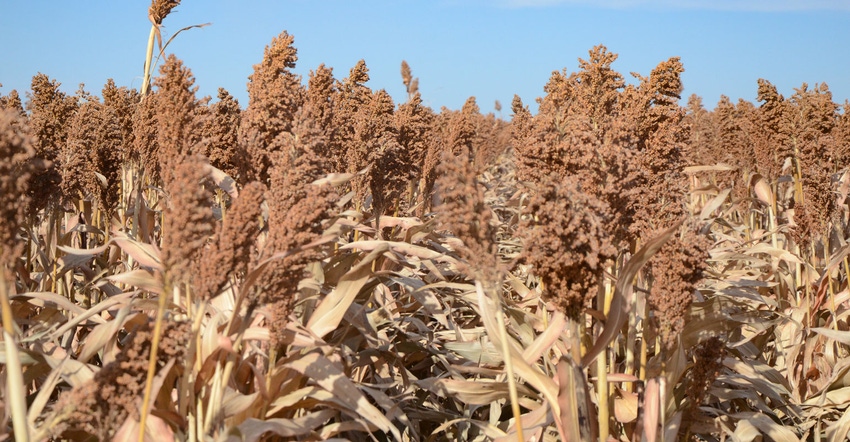September 2, 2019

By Tiffany Lee
Sorghum, the third most abundant cereal crop in the U.S., is emerging as a star player in the biofuels industry. With its water-use efficiency, resistance to heat and low cost of seed, it has the capacity to outpace corn, especially in the West and High Plains where irrigation supply limits agricultural productivity more than land availability.
Right now, however, maximizing the crop's potential is challenging. The function of much of its genome — its complete set of DNA — remains a mystery. Without pinpointing the function of more of sorghum's roughly 30,000 genes, researchers can't fully optimize sorghum for biofuel production.
That's the problem a group of University of Nebraska-Lincoln researchers, led by plant geneticist James Schnable, has set out to address. The team recently earned a $2.7 million, three-year grant from the U.S. Department of Energy to develop a rapid, efficient method for characterizing the functions of genes in sorghum.
The Nebraska scientists are leading a team of institutions from across the Corn Belt — including Iowa State University, Michigan State University, Purdue University and the University of Illinois at Urbana-Champaign — in this effort.
Their approach, an innovative merger of machine learning and plant genetics, will pave the way for sorghum strains designed to thrive in specific environments. The method also could extend to other crops such as corn and soybeans, the majority of whose genes are unstudied.
"If we understand the details about how plants perceive and react to their environments, we can develop varieties specialized to certain parts of the U.S.," says Schnable, associate professor of agronomy and horticulture. "Right now, for many genes, we have no idea what they do."
To begin to fill these gaps, Schnable's team is using a method known as reverse genetics. It's essentially a rewind of the traditional approach, called forward genetics, where the starting point is a plant with an unusual appearance, or phenotype. Researchers find the odd-looking plant, then try to determine which genes are responsible.
With reverse genetics, the process moves the other direction. Scientists start with a known gene, alter that specific gene, then analyze the characteristics of the resulting plant, shedding light on the gene's function. Although the approach has been used for more than a decade, in most cases, altering the gene has no effect. Identifying the right genes to study is like digging for a needle in a haystack.
To overcome this, Schnable's team is devising a systematic method for selecting which genes it makes sense to investigate. It centers on machine learning — the process of teaching computers to make decisions by exposing them to mountains of previously collected data.
For this project, the researchers will feed the machine extensive information about sorghum and corn genes that already have been studied.
From this data, the computer will learn to recognize patterns indicating that a certain type of gene likely plays an outsized role in determining sorghum's characteristics. Once refined, the algorithm will spare researchers the cumbersome process of randomly picking a gene, mutating it and coming up empty-handed.
Along with researching sorghum, Schnable also is developing a stalk-worn sensor for corn that will help his team better understand and eventually improve how it responds to drought.
"People in the lab have found that when a gene does yield something weird in the plant, these genes look really different from others in the genome," Schnable says. "We're going to use this information to train computers to identify other genes likely to have big effects on plants when they're mutated."
After the system identifies promising genes, Schnable's team will edit them and measure the resulting sorghum for traits such as stress response, nutrient and water-use efficiency, and biomass — the amount of organic material available to produce renewable energy.
To this point, much research has focused on identifying crop varieties that perform well across large parts of the country, from eastern Nebraska to central Illinois, for example. But with a deeper understanding of how sorghum's genes function, the focus can shift to developing breeds that flourish in smaller geographical pockets with fewer inputs. This strategy could boost overall sorghum production for fuel, food and animal feed.
The project is among the first to marry artificial intelligence and plant science, a combination that started gaining momentum over the past 18 months, Schnable says. He expects the method to open new doors in plant genetics.
"There is so much potential when you start communicating between two different academic silos that haven't been talking to each other before," he says.
The interdisciplinary approach is reflected in the team's composition. The Nebraska group also includes Yufeng Ge, associate professor of biological systems engineering, and Brandi Sigmon, assistant professor of practice in plant pathology. Researchers from other universities include statisticians, engineers and geographers.
The project is funded by the Department of Energy's Genomics-enabled Plant Biology for Determination of Gene Function program.
Lee is a research communication specialist for UNL's Office of Research and Economic Development.
Source: UNL CropWatch, which is solely responsible for the information provided and is wholly owned by the source. Informa Business Media and all its subsidiaries are not responsible for any of the content contained in this information asset.
You May Also Like




